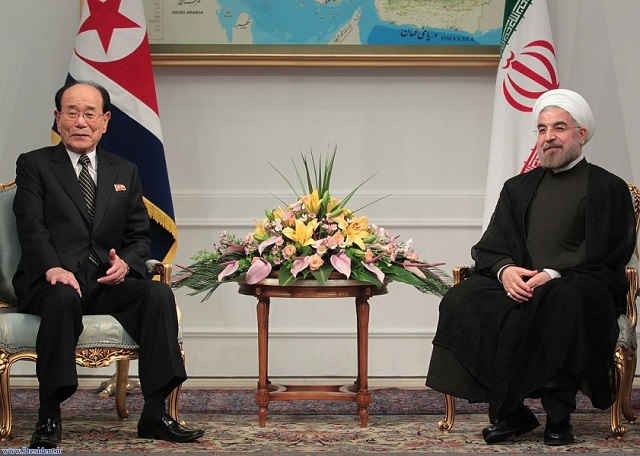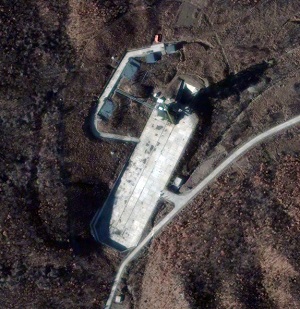Is the U.S. State Department Taking Reports of North Korea-Iranian Nuclear Cooperation Seriously?
At today’s State Department Daily Press Briefing, spokesperson Jeff Rathke was asked by Matt Lee, AP White House correspondent about reports by the Paris-based Iranian dissident group, the National Council of Resistance in Iran (NCRI) about alleged North Korean meetings in Iran alleging discussions over nuclear program cooperation an ICBM developments. Reuters reported the NCRI group allegation that:
Citing information from sources inside Iran, including within Iran’s Revolutionary Guards Corps, the Paris-based NCRI said a seven-person North Korean Defense Ministry team was in Iran during the last week of April. This was the third time in 2015 that North Koreans had been to Iran and a nine-person delegation was due to return in June, it said.
“The delegates included nuclear experts, nuclear warhead experts and experts in various elements of ballistic missiles including guidance systems,” the NCRI said.
In response to AP’s Lee question Rathke said, “We are taking these allegations very seriously” citing various UN Security Council Resolutions sanctioning the proliferation behavior of the DPRK. That led Lee and other correspondents to inquire whether this would impact the current P5+1 negotiations in Vienna seeking to conclude a comprehensive Joint Plan of Action by June 30th. We posted yesterday that France’s Foreign Minister demanding that Iran agree to UN IAEA inspectors be given full access to military facilities for verification of prior developments.
Watch this C-SPAN video clip on the exchanges between State Department Jeff Rathke and AP’s Lee and other reporters at today’s Press Briefing:
The Reuters report gave indications of previous unverified reports about such cooperation between the DPRK and Iran:
The NCRI said the North Korean delegation was taken secretly to the Imam Khomenei complex, a site east of Tehran controlled by the Defense Ministry. It gave detailed accounts of locations and who the officials met.
It said the delegation dealt with the Center for Research and Design of New Aerospace Technology, a unit of nuclear weaponization research, and a planning center called the Organization of Defensive Innovation and Research, which is under U.S. sanctions.
Reuters could not independently verify the allegations.
“Tehran has shown no interest in giving up its drive to nuclear weapons. The weaponization program is continuing and they have not slowed down the process,” NCRI spokesman Shahin Gobadi said.
U.N. watchdog the IAEA, which for years has investigated alleged nuclear arms research by Tehran, declined to comment. North Korean officials were not available for comment.
Several Western officials said they were not aware of a North Korean delegation traveling to Iran recently.
A Western diplomat said there had been proven military cooperation between Iran and North Korea in the past.
North Korean and Iranian officials meet in the course of general diplomacy. On April 23, Kim Yong Nam, North Korea’s ceremonial head of state and Iran’s president held a rare meeting on the sidelines of the Asian-African summit in Jakarta.
My colleague Ilana Freedman and this writer have reported on Iranian and DPRK on both nuclear and ICBM developments and nuclear tests in NER and Iconoclast posts. In a March 2014, NER, article, “Has Iran Developed Nuclear Weapons in North Korea”, we cited Freedman reporting:
According to my sources, Iran began moving its bomb manufacturing operations from Iran to North Korea in December 2012. Two facilities near Nyongbyon in North Pyongan province, some 50 miles north of Pyongyang, have become a new center for Iran’s nuclear arms program.
Over the last year, Iran has been secretly supplying raw materials to the reactor at Nyongbyon for the production of plutonium. At a second facility, located about fifteen miles north and with a code name that translates to ‘Thunder God Mountain’, nuclear warheads are being assembled and integrated with MIRV platforms. MIRVs are offensive ballistic missile systems that can support multiple warheads, each of which can be aimed at an independent target, but are all launched by a single booster rocket. Approximately 250-300 Iranian scientists are now reported to be in North Korea, along with a small cadre of IRGC personnel to provide for their security.
According to the reports, the Iranian-North Korean collaboration has already produced the first batch of fourteen nuclear warheads. A dedicated fleet of Iranian cargo aircraft, a combination of 747′s and Antonov heavy-lifters, which has been ferrying personnel and materials back and forth between Iran and North Korea, is in place to bring the assembled warheads back to Iran.
In a June 2014, Iconoclast post, “Does Iran/ North Korean Nuclear & ICBM Development Preclude A P5+1 Agreement?” we cited a Wall Street Journal report by Claudia Rosett, journalist in residence at the Foundation for Defense of Democracies, Iran Could Outsource Its Nuclear –Weapons Program to North Korea. Rosett commented:
The pieces have long been in place for nuclear collaboration between the two countries. North Korea and Iran are close allies, drawn together by decades of weapons deals and mutual hatred of America and its freedoms. Weapons-hungry Iran has oil; oil-hungry North Korea makes weapons. North Korea has been supplying increasingly sophisticated missiles and missile technology to Iran since the 1980s, when North Korea hosted visits by Hasan Rouhani (now Iran’s president) and Ali Khamenei (Iran’s supreme leader since the death of Ayatollah Khomeini in 1989).
Rosett in the WSJ oped lays out the case for what the NER article demonstrated was a plausible means of evading sanctions. The evidence for that we noted was North Korean/ Iranian cooperation with Assad’s Syria creating a plutonium reactor on the Euphrates at Al Kibar destroyed by Israel’s Air Force in September 2007. We drew attention to Iranian/ North Korean joint development of large rocket boosters sufficient to loft nuclear MIRV warheads and the likelihood that Iran might have that capability within a few years. In June 2014, The Algemeiner reported an Iranian official announcing that it possessed a 5,000 kilometer (approximately 3,125 miles) range missile that could hit the strategic base of Diego Garcia in the Indian Ocean:
“In the event of a mistake on the part of the United States, their bases in Bahrain and (Diego) Garcia will not be safe from Iranian missiles,” said an Iranian Revolutionary Guard adviser to Iranian leader Ayatollah Ali Khamenei, Majatba Dhualnuri.
In an April 15, 2015, Iconoclast post, “Obama Administration Knew of Illegal North Korea Missile Technology Transfers to Iran During Talks” we reported:
Bill Gertz has a blockbuster expose in today’s Washington Free Beacon of something we have been hammering away for years: the technology transfer of missile and nuclear technology between North Korea and the Iran, “North Korea Transfers Missile Goods to Iran During Nuclear Talks.” The stunning disclosure was that U.S. intelligence has known about the illegal transfer in violation of UN arms sanctions, as apparently did the Obama Administration. You recall the statement that Undersecretary of State Wendy Sherman made before a Senate hearing in early 2014. Sherman said, “that if Iran can’t get the bomb then its ballistic missiles would be irrelevant.”
Gertz went on to report:
Since September more than two shipments of missile parts have been monitored by U.S. intelligence agencies as they transited from North Korea to Iran, said officials familiar with intelligence reports who spoke on condition of anonymity.
Details of the arms shipments were included in President Obama’s daily intelligence briefings and officials suggested information about the transfers was kept secret from the United Nations, which is in charge of monitoring sanctions violations.
While the CIA declined to comment on these allegations claiming classified information, others, Gertz queried said that “such transfers were covered by the Missile Technology Control Regime, a voluntary agreement among 34 nations that limits transfers of missiles and components of systems with ranges of greater than 186 miles.”
One official said the transfers between North Korea and Iran included large diameter engines, which could be used for a future Iranian long-range missile system.
The compilation of these reports and today’s exchange at the State Department Press Briefing clearly raises the ante as to why in one reporter’s query, ‘our negotiators” haven’t simply asked Foreign Minister Zarif in Vienna is there such cooperation going on, backed up by the intelligence reports cited by Gertz and others? Our suspicion is that French Foreign Minister Fabius has better feed on Iranian nuclear and ICBM developments than our CIA. Or more likely is the Obama West Wing suggesting not to believe those lying reports in the President’s Daily Intelligence Briefing? After all, President Obama, Secretary Kerry and Undersecretary of State for Political Affairs Wendy Sherman want nothing to stand in the way of an agreement with Iran, even it means evading the truth. Stay tuned for developments.
EDITORS NOTE: This column originally appeared in the New English Review. The featured image is from the official site of the President of The Islamic Republic of Iran.




